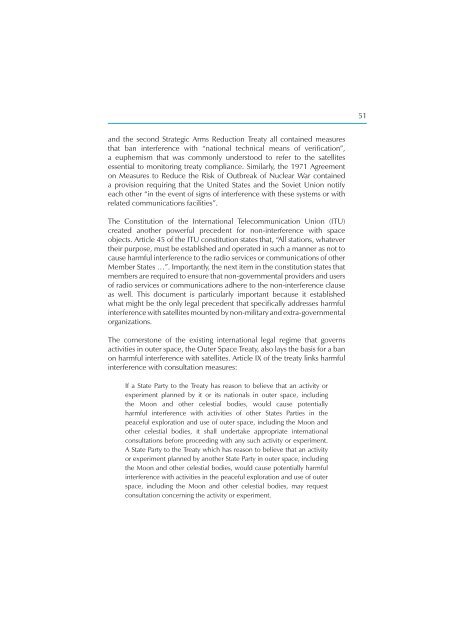Security in Space The Next Generation - UNIDIR
Security in Space The Next Generation - UNIDIR
Security in Space The Next Generation - UNIDIR
Create successful ePaper yourself
Turn your PDF publications into a flip-book with our unique Google optimized e-Paper software.
and the second Strategic Arms Reduction Treaty all conta<strong>in</strong>ed measures<br />
that ban <strong>in</strong>terference with “national technical means of verifi cation”,<br />
a euphemism that was commonly understood to refer to the satellites<br />
essential to monitor<strong>in</strong>g treaty compliance. Similarly, the 1971 Agreement<br />
on Measures to Reduce the Risk of Outbreak of Nuclear War conta<strong>in</strong>ed<br />
a provision requir<strong>in</strong>g that the United States and the Soviet Union notify<br />
each other “<strong>in</strong> the event of signs of <strong>in</strong>terference with these systems or with<br />
related communications facilities”.<br />
<strong>The</strong> Constitution of the International Telecommunication Union (ITU)<br />
created another powerful precedent for non-<strong>in</strong>terference with space<br />
objects. Article 45 of the ITU constitution states that, “All stations, whatever<br />
their purpose, must be established and operated <strong>in</strong> such a manner as not to<br />
cause harmful <strong>in</strong>terference to the radio services or communications of other<br />
Member States …”. Importantly, the next item <strong>in</strong> the constitution states that<br />
members are required to ensure that non-governmental providers and users<br />
of radio services or communications adhere to the non-<strong>in</strong>terference clause<br />
as well. This document is particularly important because it established<br />
what might be the only legal precedent that specifi cally addresses harmful<br />
<strong>in</strong>terference with satellites mounted by non-military and extra-governmental<br />
organizations.<br />
<strong>The</strong> cornerstone of the exist<strong>in</strong>g <strong>in</strong>ternational legal regime that governs<br />
activities <strong>in</strong> outer space, the Outer <strong>Space</strong> Treaty, also lays the basis for a ban<br />
on harmful <strong>in</strong>terference with satellites. Article IX of the treaty l<strong>in</strong>ks harmful<br />
<strong>in</strong>terference with consultation measures:<br />
If a State Party to the Treaty has reason to believe that an activity or<br />
experiment planned by it or its nationals <strong>in</strong> outer space, <strong>in</strong>clud<strong>in</strong>g<br />
the Moon and other celestial bodies, would cause potentially<br />
harmful <strong>in</strong>terference with activities of other States Parties <strong>in</strong> the<br />
peaceful exploration and use of outer space, <strong>in</strong>clud<strong>in</strong>g the Moon and<br />
other celestial bodies, it shall undertake appropriate <strong>in</strong>ternational<br />
consultations before proceed<strong>in</strong>g with any such activity or experiment.<br />
A State Party to the Treaty which has reason to believe that an activity<br />
or experiment planned by another State Party <strong>in</strong> outer space, <strong>in</strong>clud<strong>in</strong>g<br />
the Moon and other celestial bodies, would cause potentially harmful<br />
<strong>in</strong>terference with activities <strong>in</strong> the peaceful exploration and use of outer<br />
space, <strong>in</strong>clud<strong>in</strong>g the Moon and other celestial bodies, may request<br />
consultation concern<strong>in</strong>g the activity or experiment.<br />
51








